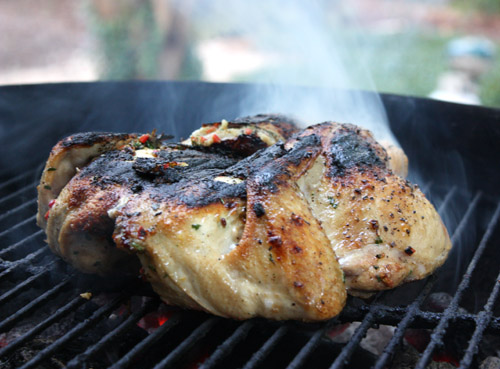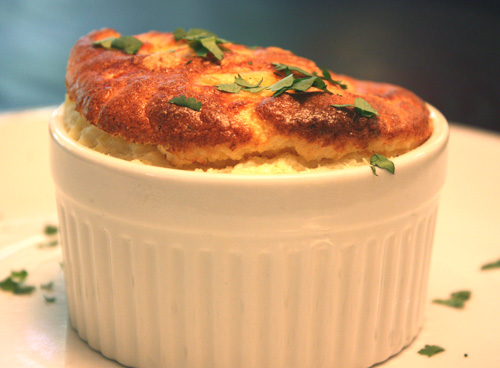 How weird, anal, and obsessive is my recipe collecting? You don’t really want to know. I’ll just say that for years I’ve been cutting photos and recipes out of magazines and filing them by category. One of those magazines is Living, and its recipes get their own filing system. Recipes from other food publications have a separate system of their own. Too much information? You don’t want to see the files or how they’re overflowing at this point. The important thing is that I do actually, eventually thumb through them for inspiration.
How weird, anal, and obsessive is my recipe collecting? You don’t really want to know. I’ll just say that for years I’ve been cutting photos and recipes out of magazines and filing them by category. One of those magazines is Living, and its recipes get their own filing system. Recipes from other food publications have a separate system of their own. Too much information? You don’t want to see the files or how they’re overflowing at this point. The important thing is that I do actually, eventually thumb through them for inspiration.  In Living, there’s a section each month called What’s for Dinner, and four recipe cards are included with photos on the front sides. They get their own file folder. Well, at long last, a What’s for Dinner dating from March 2003 made it to our table last Sunday. As it appeared on the recipe cards, it was
In Living, there’s a section each month called What’s for Dinner, and four recipe cards are included with photos on the front sides. They get their own file folder. Well, at long last, a What’s for Dinner dating from March 2003 made it to our table last Sunday. As it appeared on the recipe cards, it was  I revised the meal a little by using a whole chicken instead of game hens, and the chicken was spatchcocked and grilled instead of roasted. The chicken was prepared as follows:
I revised the meal a little by using a whole chicken instead of game hens, and the chicken was spatchcocked and grilled instead of roasted. The chicken was prepared as follows:3 garlic cloves, minced
2 T minced fresh ginger
2 fresh red Fresno chiles, seeded and finely chopped
3 T chopped fresh cilantro
1 T lime juice
1 t soy sauce
¼ c canola oil
½ c hoisin sauce
-remove backbone from chicken and flatten it with wings tucked back
-mix all ingredients except hoisin together and spoon mixture over both sides of chicken and rub under skin; refrigerate until ready to grill
-grill over high heat for seven to ten minutes per side, then move chicken to a cooler side of the grill; baste with hoisin sauce and cook for ten minutes; turn and baste other side and cook until juices run clear when pierced, about another ten minutes
 Note about hoisin sauce: Some brands list sugar as the first ingredient and contain astronomical amounts of sodium. I chose House of Tsang brand because the first ingredient listed is fermented soybean paste, it contains no msg, and it is much lower in sodium and sugar than others.
Note about hoisin sauce: Some brands list sugar as the first ingredient and contain astronomical amounts of sodium. I chose House of Tsang brand because the first ingredient listed is fermented soybean paste, it contains no msg, and it is much lower in sodium and sugar than others. For the asparagus and shitake stir-fry, my only change was adding red bell pepper. The plated chicken and vegetables were sprinkled with black and white sesame seeds and chopped cilantro. I’m glad I kept these recipes. Hoisin makes a great barbeque sauce, and this was another really easy meal.
 What will I do if I ever make it through all of my files? What if they’re left empty with nothing remaining to cook? I’ll just keep reading so that never happens.
What will I do if I ever make it through all of my files? What if they’re left empty with nothing remaining to cook? I’ll just keep reading so that never happens.

Tweet



















 Now, Kurt likes to point out that, due to my Illinois upbringing, I’m a sucker for fresh corn. He’s from Illinois too, but I really love fresh corn (and popcorn and cornmeal and polenta and grits). I can tell good fresh corn from so-so fresh corn and several levels of ok-ness in the middle. Small-kerneled, crunchy white corn can be the very best there is, but big, juicy yellow kernels are undeniably addictive. But, even if you only moderately like corn, like normal people, you will really like this dish. It was in the category of I can’t believe I made this it’s so good.
Now, Kurt likes to point out that, due to my Illinois upbringing, I’m a sucker for fresh corn. He’s from Illinois too, but I really love fresh corn (and popcorn and cornmeal and polenta and grits). I can tell good fresh corn from so-so fresh corn and several levels of ok-ness in the middle. Small-kerneled, crunchy white corn can be the very best there is, but big, juicy yellow kernels are undeniably addictive. But, even if you only moderately like corn, like normal people, you will really like this dish. It was in the category of I can’t believe I made this it’s so good. 









 Grilled ruby trout alongside the salad completed the meal. Not only was it delicious, the look of the salad is very striking on the plate. The only negative note is that those red beets will stain your cutting board, but they’re worth it. And,
Grilled ruby trout alongside the salad completed the meal. Not only was it delicious, the look of the salad is very striking on the plate. The only negative note is that those red beets will stain your cutting board, but they’re worth it. And, 
 5 oz goat cheese at room temperature
5 oz goat cheese at room temperature








 The eggs don’t exactly poach since there isn’t room for them to be completely immersed. Instead, they’re sort of soft fried. The spicy chiles, the melted cheese, and the crunchy garnishes make this dish a satisfying morning meal. Next time, I’ll have some warm corn tortillas ready as an accompaniment. In fact, now that I’ve thought of that, I can’t wait to make it again.
The eggs don’t exactly poach since there isn’t room for them to be completely immersed. Instead, they’re sort of soft fried. The spicy chiles, the melted cheese, and the crunchy garnishes make this dish a satisfying morning meal. Next time, I’ll have some warm corn tortillas ready as an accompaniment. In fact, now that I’ve thought of that, I can’t wait to make it again.